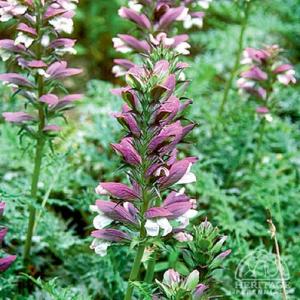Bear breeches can stand low temperatures
The Corinthian column of Greece dates back 2,400 years and features acanthus leaves. The leaves have soft spines, giving them the nickname Bear's Breeches (Acanthus spinosus). These plants bloom with up to 30 stunning maroon-and-white flowers on 36-48-inch stalks during early to mid-summer.
The flowers attract hummingbirds. These are large plants that will spread up to three feet across. The snow-white, snapdragon-like flowers have small hoods of maroon or purple that rise three to four feet above the mounding plants. The dark, deeply cut leaves stay attractive all during the growing season.
This Mediterranean native spread throughout Europe thanks to the Romans, who used poultices from the boiled roots to treat gout, burns, sprains, and even baldness. Like modern gardeners, the Romans also used acanthus in the flower garden and to line walkways and paths. Dry the flowers by hanging them upside-down in a cool, dark place, out of direct sunlight.
Once established, bear breeches will put up with low temperatures as long as you provide good drainage. Because of their massive roots, they will live for years without attention.
Plant bear breeches in well-drained soil in partial shade. They do best in rich soil with plenty of compost or other organic matter. Once established, they are tolerant of poor soil, but they must have good drainage, especially in winter. If their roots sit in cold, wet soil it will kill the plant. Even though they are not particular about soil pH, they grow easiest with a soil pH from 6.5 to 7.5.
Bear breeches make great companions to hostas or other shade-loving plants. The plants will die back to the ground every winter. Use a protective mulch for the first few winters.
Like many herbs, all acanthus tend to perform unevenly, even when grown under the best conditions, so once in awhile they just don't flower at all. Even though they tolerate dense shade, they will have fewer, if any blossoms. They are hardy in USDA zones 5-9.
It is hard to find seed, but if you can get viable seed, plant it in early spring. Seed-grown plants will take several years before they bloom. Because of their long tap roots they do not like to be moved.
To divide your plants, jab a shovel through the base of the plant's roots. This is best done in the fall. The following spring, you will be rewarded with many new baby plants ready for transplanting.
If snails or slugs chew holes in the leaves, put out shallow bowls of beer to trap them.
You can also use diatomaceous earth to control the pests. These plants are resistant to damage from deer or rabbits.
With glossy green spiny leaves and long-lasting flowers, bear breeches look exotic and nearly tropical. This ancient plant that inspired Greek architects will reward you for many years to come. It is, as they say, a classic.

















































